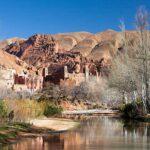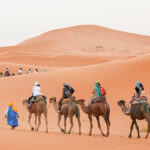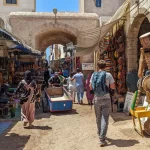Nestled in the majestic Atlas Mountains, just a stone’s throw away from the bustling streets of Marrakech, lies a tranquil haven that seems almost like a mirage in its idyllic splendor – the Ourika Valley. This enchanting valley, a tapestry of lush greenery, meandering streams, and quaint Berber villages, starkly contrasts the red city of Marrakech, offering a serene escape into nature’s embrace.
Ourika Valley is not just a feast for the eyes; it’s a symphony of experiences. Here, the natural beauty intertwines seamlessly with the rich cultural tapestry of the Berber communities, making it a mosaic of Moroccan life. From the olive groves’ rustling leaves to the snow-capped mountains’ distant peaks, every valley corner tells a story of harmony between humankind and nature.
As you embark on this journey through my words, picture yourself winding through the verdant landscapes, the air filled with the scent of wild herbs, and the sound of flowing water accompanying every step. This blog aims to unravel the many layers that make Ourika Valley a must-visit destination. Whether you are a keen adventurer seeking to conquer the rugged mountain trails, a culture enthusiast avid to delve into the rich heritage of the Berber tribes, or simply someone searching for a peaceful retreat far away from the urban lifestyle, Ourika Valley has something for everyone.
Join me as we explore the many facets of this hidden gem – from its breathtaking natural wonders and rich cultural heritage to the myriad of activities it offers and its easy accessibility. Together, let’s discover why Ourika Valley is not just a destination but an experience, an adventure, and a journey into the heart of Moroccan allure.
Table of contents
Natural Beauty of Ourika Valley

Landscape: A Tapestry of Rolling Hills and Rugged Peaks
The Ourika Valley greets its visitors with a landscape that melds rolling hills and rugged peaks of the Atlas Mountains. Olive trees and wildflowers dot these hills, while the dramatic rocky outcrops of the mountains provide a stark, breathtaking contrast.
Flora: A Fusion of Alpine and Desert Vegetation
The valley is a botanist’s dream, showcasing an eclectic mix of alpine and desert plants. Fragrant wild herbs like thyme and rosemary are abundant. The area bursts into vibrant colors in spring with blooming flowers, including the rare Atlas tulip.
Fauna: Bird Species and Small Mammals
Birdwatchers can delight in observing various local bird species, including majestic eagles and colorful songbirds. The valley is also home to small mammals, notably the playful Barbary macaques, adding a notion to the serene environment.
The Setti Fatma Waterfalls: A Natural Marvel
A highlight of the valley is the Setti Fatma Waterfalls, a series of seven cascades hidden in the mountains. The journey to these waterfalls, involving a scenic hike, offers breathtaking views and culminates in the magnificent spectacle of cascading waters.
The Serene Ourika River: Heart of the Valley
The Ourika River, with its crystal-clear waters, meanders through the valley, creating lush banks. This serene river is not just a picturesque element but the lifeline of the valley, offering tranquil spots for picnics and reflection amidst the stunning natural backdrop.
Cultural Richness of Ourika Valley

The Indigenous Berber Communities
The soul of Ourika Valley is embodied in its indigenous Berber communities. These resilient and hospitable people have lived in harmony with the harsh mountain landscapes for centuries.
- Traditions and Lifestyle: The Berbers, known locally as Amazigh, have rich traditions in their daily lives. Their language, Tamazight, echoes through the valley, a reminder of a culture that predates Arab influence. Traditional Berber homes from local materials offer insight into their sustainable lifestyle.
- Cultural Insights: Berber culture is deeply connected to the land. Their agricultural practices, celebrations, and social structures are a window into a way of life that balances the modern with the ancestral. Visitors often experience the warmth of Berber hospitality through shared mint tea or a meal, a practice deeply ingrained in their culture.
Historical Aspects of the Valley
- Historical Significance: While Ourika Valley may seem timeless, it is steeped in history. The valley has witnessed the ebb and flow of various civilizations and served as a crucial link in trade routes across the Atlas Mountains.
- Historical Sites: There are remnants of historical significance scattered throughout the valley, from ancient granaries to ruins of old fortifications. Although not as glorious as others in Morocco, these sites offer a subtle yet profound connection to the past.
• Events of Note: The valley has also been the site of pivotal events, including battles and strategic gatherings, which have shaped local history. These stories are often preserved in the oral histories of the Berber people, adding a rich layer to the valley’s historical tapestry.
Vibrant Markets and Artisanal Heritage
- Market Atmosphere: The markets of Ourika Valley are a sensory overload in the best way possible. Colors, sounds, and smells mingle to create a quintessentially Moroccan atmosphere.
- Artisanal Goods: These markets showcase the valley’s rich artisanal heritage. Local artisans sell handcrafted goods, from intricately woven rugs to beautifully crafted pottery. Each piece reflects the skill and creativity of its maker, often passed down through generations.
- Cultural Exchange: These markets are places of commerce and cultural exchange. They offer visitors the unique opportunity to interact with the local community, learn about traditional crafts, and take home a piece of the valley’s soul.
The cultural richness of Ourika Valley is a tapestry woven from the lives and history of its people. It is a place where the past and present coexist, where traditions are cherished, and where visitors can immerse themselves in the depth and diversity of Moroccan culture.
Adventure and Activities in Ourika Valley

Hiking Trails: From Leisurely Walks to Challenging Treks
The valley offers many hiking trails that cater to every level of experience, from leisurely walks along the river to challenging treks up the mountain slopes.
- Easy Trails: For those seeking a gentle introduction to the valley’s beauty, numerous trails meander through the lush landscapes, passing through Berber villages and alongside the river, offering serene views and the chance to experience local life.
- Challenging Treks: For the more adventurous, challenging routes ascend the Atlas Mountains’ higher reaches, enhancing the appeal of Atlas Mountains treks. These hikes offer breathtaking views and the thrill of navigating rugged terrain. Some lead to remote villages, allowing hikers to witness the untouched beauty and simplicity of Berber life.
- Guided Hikes: Visitors can opt for guided hikes, which provide valuable insights into the local flora, fauna, and culture, enhancing the hiking experience.
Adventure Sports: Thrills in the Heart of Nature
Ourika Valley is a haven for hikers and a playground for adventure sports enthusiasts.
- Mountain Biking: The varied terrain of the valley makes it a perfect ground for mountain biking. Biking trails offer a mix of challenging climbs, exhilarating descents, and breathtaking scenery.
- Rock Climbing: The Atlas Mountains’ rugged cliffs present rock climbing opportunities, catering to various skill levels. Climbing these natural formations is a thrilling way to experience the valley’s beauty up close.
- Rafting and Kayaking: For those who love water sports, the Ourika River, with its varying rapids, offers exciting options for rafting and kayaking, especially in the spring when the water levels are high.
Tranquil Activities: Relaxation Amidst Nature
- Bird Watching: The valley, with its diverse ecosystems, is a haven for birdwatchers. The abundant birdlife includes local and migratory species, allowing enthusiasts to spot various birds in their natural habitat.
- Picnicking and Relaxation: The valley offers numerous spots for visitors looking to unwind by the river or amid green fields. These tranquil spots provide a perfect setting to relax and admire the natural beauty of Ourika Valley.
- Photography: The picturesque landscapes, vibrant markets, and rich cultural scenes provide ample opportunities for photography enthusiasts to capture the essence of the valley.
Ourika Valley offers something for everyone with its blend of adventure and tranquility. Whether seeking the adrenaline rush of adventure sports, the peacefulness of nature walks, or the simple joy of bird watching, the valley is a destination that promises memorable experiences in the heart of nature.
Accessibility and Convenience of Ourika Valley

- Proximity to Marrakech: One of the most appealing aspects of Ourika Valley is its proximity to Marrakech. It is just a short drive away, and the valley is easily accessible by car, taxi, or bus, making it an ideal destination for day trips from Marrakech.
- Scenic Journey: The journey to the valley itself is a part of the experience, offering scenic views of the Moroccan countryside and the Atlas Mountains as one approaches the valley.
Diverse Tour Options

- Variety of Tours: Catering to the diverse interests of visitors, numerous tour operators offer a range of options to explore Ourika Valley. These tours can vary from half-day excursions to full-day adventures.
- Customized Experiences: Tours can be customized depending on interest and budget. Options include guided hiking tours, cultural tours focusing on the Berber communities, and nature-centric tours highlighting the valley’s natural beauty.
- Group and Private Tours: Visitors can choose between joining a group day tour, which is often more economical, or opting for a private Marrakech to Ourika Valley tour for a more personalized experience.
Accommodation and Dining

- Accommodation Options: Ourika Valley offers a range of accommodation options. For those seeking luxury, upscale resorts provide all modern comforts with stunning mountain views. Alternatively, numerous cozy guesthouses and traditional riads offer a more authentic Moroccan experience.
- Staying in Berber Villages: For a truly immersive experience, some visitors stay in local Berber villages, which provides a unique opportunity to experience local life and hospitality.
- Dining Experiences: The valley is also a culinary delight. Many restaurants and cafes serve traditional Moroccan cuisine, with dishes like Tagine and couscous made using fresh, local ingredients. Roadside stalls offer the chance to try local snacks and mint tea, a staple in Moroccan culture.
Recovery and Resilience: Ourika Valley Post-Earthquake

The recent earthquake in Morocco, with its epicenter in the High Atlas Mountains near the ski resort of Oukaimeden, significantly impacted the Ourika Valley. The earthquake, measuring 6.8 on the Richter scale, was one of the strongest to hit the area in over a century and resulted in widespread devastation. More than 2,600 people lost their lives due to the disaster. The quake struck approximately 75 kilometers southwest of Marrakesh. It affected many villages in the High Atlas Mountains, including areas in and around Ourika Valley.
The villages in the High Atlas Mountains were particularly hard hit, with homes and lives being destroyed. The rugged and mountainous terrain of the area made rescue and recovery efforts challenging. The earthquake’s aftermath saw a concerted effort from local and international aid workers as they assisted under challenging conditions.
Despite the severity of the earthquake, some areas, like the Ourika Valley, did not face as harsh an impact as others. For example, a family staying in a boutique hotel in the Ourika Valley during the quake reported feeling the building shake but managed to escape significant harm. However, the broader impact on the valley’s infrastructure, environment, and local communities was substantial, with recovery efforts underway.
In Marrakesh, life continued with a sense of normalcy. Still, the mood was somber, with people aware of the tragedy that struck nearby areas. The disaster led to official days of mourning and a strong focus on supporting rescue efforts.
This earthquake highlights the vulnerability of remote and rural areas like Ourika Valley to natural disasters and the importance of robust infrastructure and preparedness to mitigate such risks.
Practical Tips

- Best Time to Visit: While Ourika Valley is beautiful year-round, the best time to visit is during spring or early autumn when the weather is perfectly mild and the natural scenery is at its peak.
- Local Guides: Employing local guides can enhance the experience, offering insights into the culture, history, and natural environment of the valley.
- Transportation Tips: Parking is available in the main areas for those driving. Public transport users should know the bus schedules to plan their return to Marrakech efficiently.
Ourika Valley’s easy accessibility, with its variety of tour options and accommodation choices, makes it a convenient and adaptable destination for all travelers. Whether seeking a quick escape from the bustle of Marrakech or a deeper exploration of the valley’s wonders, Ourika Valley is a welcoming and easily accessible retreat.





































